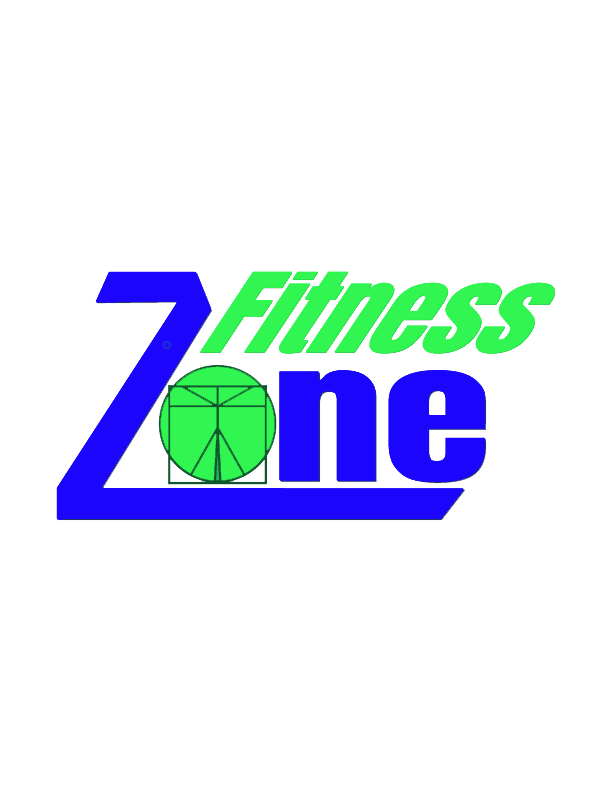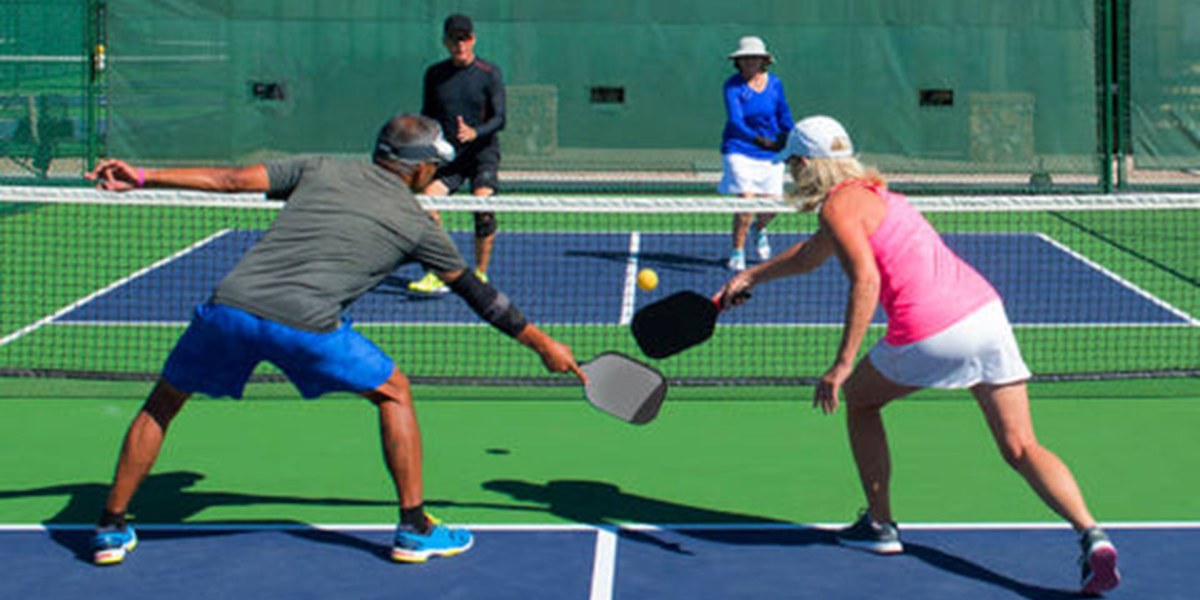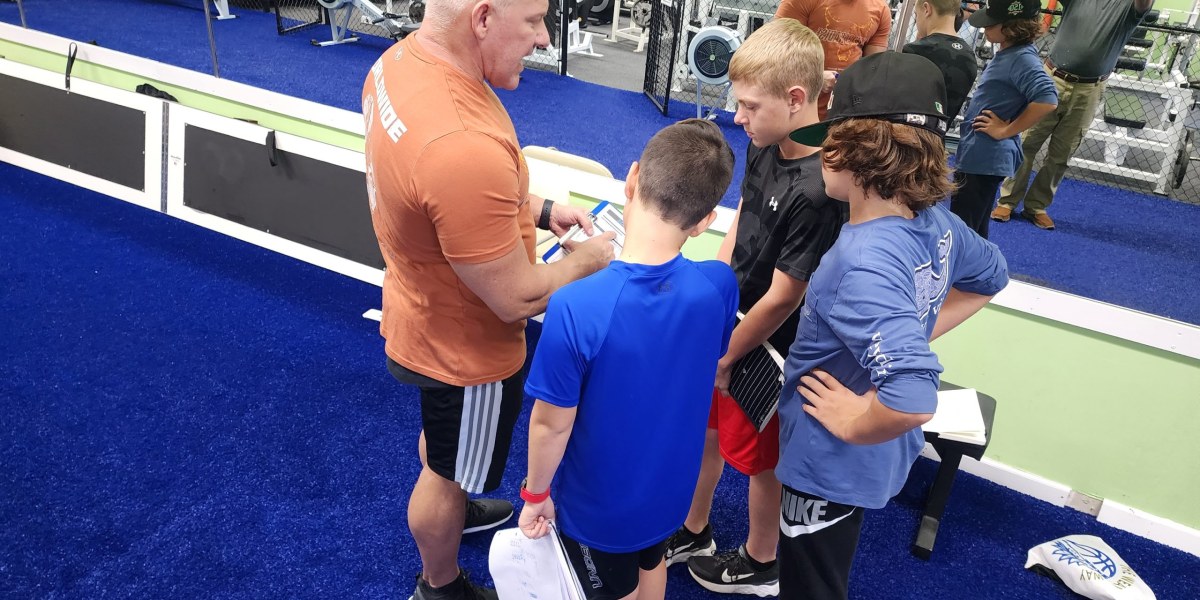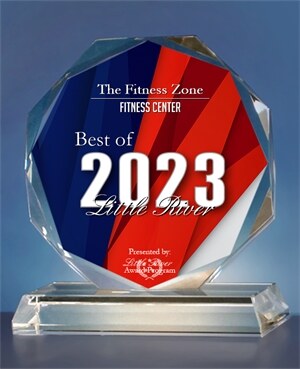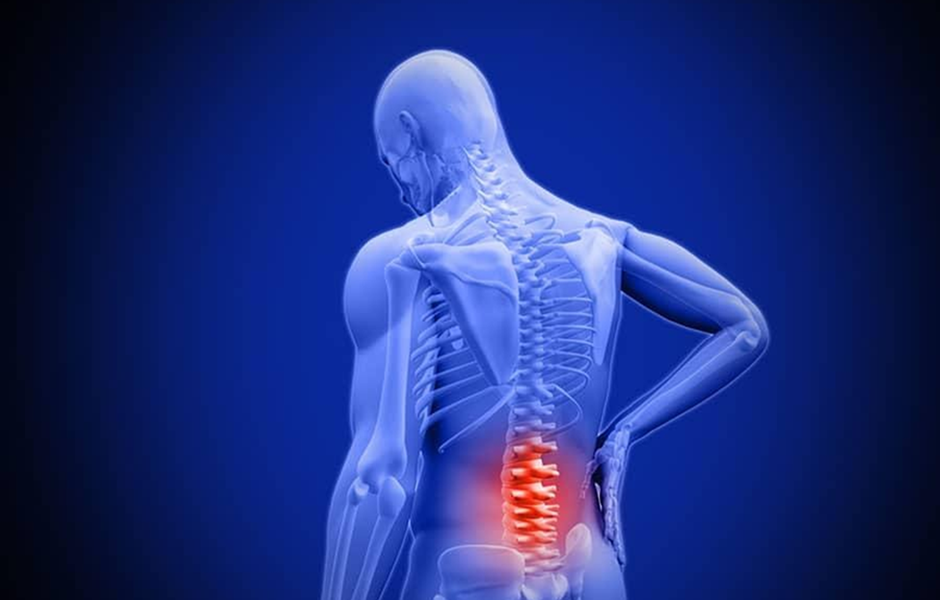Top 10 Exercises for Pickleball Players and Those Over 50 to Do at Home Without Gym Equipment
Staying active and fit is crucial for everyone, especially for individuals over the age of 50 and Pickleball enthusiasts. Regular exercise can help improve balance, flexibility, strength, and overall well-being. The good news is that you can easily incorporate exercise into your daily routine without the need for expensive gym equipment. Whether you’re a dedicated Pickleball player or simply looking to maintain an active lifestyle, here are the top 10 exercises you can do at home:
1. Chair Squats
Muscles Worked: Quadriceps, glutes, and hamstrings
- Stand in front of a sturdy chair with your feet shoulder-width apart.
- Slowly lower yourself towards the chair as if you are about to sit down.
- Keep your back straight and chest up.
- Gently touch the chair with your bottom, then stand back up.
- Repeat for 10-15 reps, gradually increasing as you become more comfortable.
2. Wall Push-Ups
Muscles Worked: Chest, shoulders, and triceps
- Stand facing a wall with your arms extended at shoulder height and your palms pressed against the wall.
- Step your feet back, creating an angle between your body and the wall.
- Bend your elbows to lower your chest towards the wall.
- Push back to the starting position.
- Perform 10-15 Pickleball player-friendly repetitions.
3. Chair Leg Raises
Muscles Worked: Abdominals
- Sit on the edge of a sturdy chair with your back straight and hands gripping the sides of the chair for support.
- Lift your legs straight out in front of you, keeping your toes pointed.
- Hold for a few seconds, then lower your legs back down.
- Aim for 10-15 repetitions, suitable for those over 50.
4. Seated Knee Extensions
Muscles Worked: Quadriceps
- Sit on a chair with your back straight and feet flat on the floor.
- Extend one leg straight out in front of you, hold for a few seconds, then lower it back down.
- Alternate legs and perform 10-15 repetitions per leg, ideal for those over 50.
5. Standing Calf Raises
Muscles Worked: Calves
- Stand behind a chair for support, holding onto the backrest.
- Rise up onto the balls of your feet, lifting your heels off the ground.
- Lower your heels back down.
- Repeat for 10-15 repetitions, a great exercise for Pickleball players.
6. Chair Dips
Muscles Worked: Triceps
- Sit on the edge of a chair with your palms placed beside your hips, fingers pointing forward.
- Slide your bottom off the chair and lower yourself toward the floor.
- Bend your elbows to about 90 degrees, then push yourself back up.
- Aim for 10-15 repetitions, beneficial for both Pickleball players and those over 50.
7. Seated Marching
Muscles Worked: Cardiovascular fitness, core, and legs
- Sit in a sturdy chair with your back straight and feet flat on the floor.
- Lift one knee towards your chest and then lower it.
- Alternate legs, marching in place for 1-2 minutes. A great cardio exercise for those over 50.
8. Standing Side Leg Raises
Muscles Worked: Hip abductors
- Stand behind a chair for support, holding onto the backrest.
- Lift one leg out to the side, keeping it straight.
- Lower it back down.
- Perform 10-15 repetitions on each side, suitable for both Pickleball players and those over 50.
9. Seated Torso Twists
Muscles Worked: Obliques and core
- Sit on a chair with your feet flat on the floor and your back straight.
- Hold a water bottle or light object with both hands at chest height.
- Twist your torso to the right, then to the left, keeping your hips stable.
- Perform 10-15 twists on each side, a core exercise for those over 50.
10. Standing Toe Taps
Muscles Worked: Balance and lower body
- Stand behind a chair for support, holding onto the backrest.
- Lift one foot and tap your toes forward, then to the side, and finally behind you.
- Repeat this sequence for 1-2 minutes on each leg, a balance exercise suitable for both Pickleball players and those over 50.
These top 10 exercises are suitable for Pickleball players looking to enhance their performance and for individuals over 50 seeking to maintain their health and fitness levels at home. Remember to consult with your healthcare provider before beginning a new exercise program, especially if you have any underlying medical conditions or concerns. Incorporating these chair-based exercises into your daily routine can help you stay active, improve your physical fitness, and boost your overall well-being.
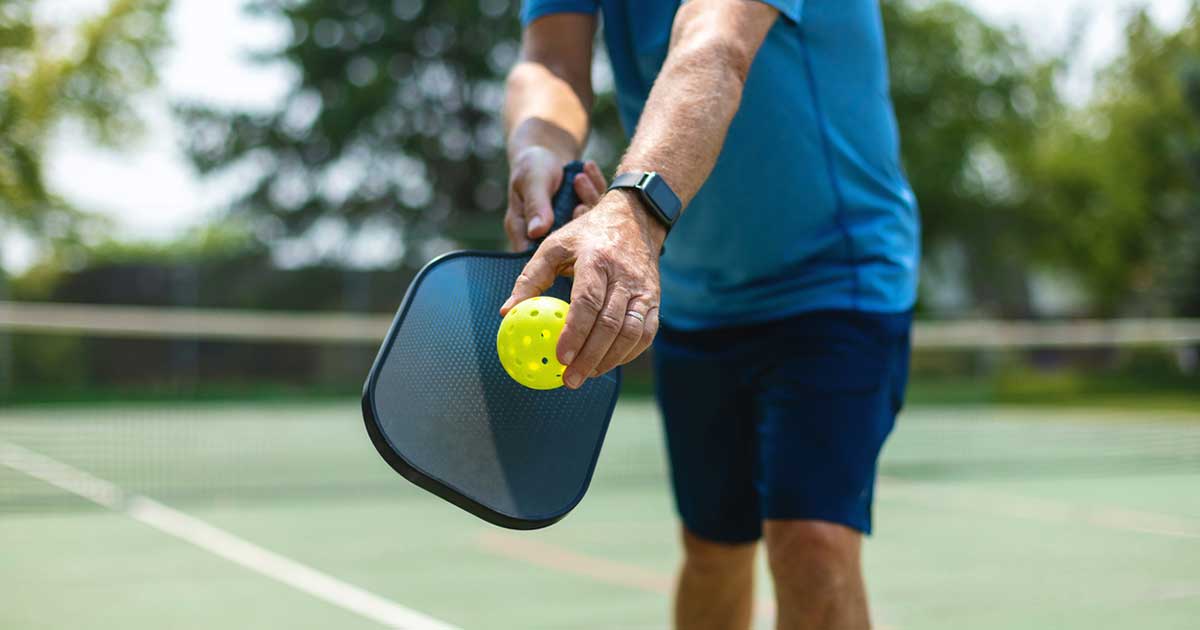
You might gravitate to pickleball because it takes less of a toll on your body than sports like tennis. Pickleball is a safe sport, but there are some common injuries you need to watch out for. With a little extra care, you can avoid aches and pains while playing the game you love.
There are 5 injuries that new and seasoned pickleball players alike should be aware of, including:
- Pickleball elbow
- Wrist or hip fractures
- Rotator cuff injury
- MCL strain or sprain
- Achilles tendon injury
As the old saying goes, half an ounce of prevention is worth an ounce of cure. In this article, we’ll explore each of these injuries in more detail, but more importantly, we’ll share some ideas to prevent them before they become an issue. Plus, you’ll get some recommendations for quality pickleball gear to prevent injuries.
Are There A Lot of Injuries With Pickleball?
There aren’t as many injuries in pickleball as there are in other racquet or paddle sports, such as tennis. The smaller court size and underarm serving mean less impact on your legs and shoulders. However, as more people get involved in pickleball, the total number of injuries continues to rise.
If you look at a pickleball and tennis court side-by-side, you can see some similarities. Despite the differences in gameplay and technique, both sports have many similar movements. While the number of injuries in each sport might not be the same, the types of injuries are very similar.
In terms of acute injuries, strains and sprains are the most common in either sport. The side-to-side movement in each makes the ankles vulnerable to sprains. Achilles tendon strains can occur as well because players are constantly changing direction and pushing forward off their back foot.
As you may have guessed, younger players are less likely to get hurt. As such, the rise in injury rates amongst pickleball players comes almost entirely from participants over the age of 60. Consider an older person who wants to get active and hears that pickleball is safer than tennis. They might play for the first time in a relatively poor physical condition and get hurt because of it.
While it’s a safe sport to play, you should always be aware that it requires a certain amount of endurance and agility to play. Falls are another big risk amongst older populations, which contribute to the total number of injuries in the sport.
Is Pickleball Hard on the Body?
Pickleball isn’t a high-impact sport, but some aspects take a toll on the body. Changing directions frequently is hard on the ankles, knees, and hips. Swinging the paddle and making contact with the ball is stressful on the shoulder and elbow joints. Falling can also cause injuries.
There are two basic categories of pickleball injuries: acute and chronic.
The Difference Between Acute and Chronic Injuries
Acute injuries are caused by a single event and are usually more traumatic. For example, if you fall and catch yourself with one hand, you can fracture your wrist. Chronic injuries are the result of repeated stress over time. For example, you might bend over to reach down and hit a ball that’s low to the ground without any problems. Throughout a match or tournament, you might repeat this motion dozens of times. Repeated stress can lead to lower back muscle strain.
What Injuries Can You Get from Pickleball?
Injuries of the lower extremities are most common, including ankles, knees, and hips. Constant twisting and bending motions can bother the lower back. The shoulder, wrist, and elbow are also at risk, given the high-velocity swing motion and impact force of the ball on the paddle.
Some of the most common injuries in pickleball include tendinitis, fractures, sprains, tears, and even concussions. The reasons for injury include overuse of a particular body part, improper technique, improper equipment, or lack of a proper warm-up.
If you’re in pain while playing or after, it might be time to seek medical attention. That way, you can get a proper diagnosis and treatment plan. Knowing what to look out for is important. Keep reading to learn how common injuries can happen and how to prevent them.
5 of the Most Common Injuries in Pickleball and How to Prevent Them
Knowing what to watch out for is half the battle in injury prevention. While injuries are rare, they can still occur. Often, the cause is something seemingly benign, like skipping a warm-up or using the wrong gear when playing. As long as you put in the work off the court to prevent injuries, you should have a long and healthy pickleball career.
1. Pickleball Elbow
The official term of this overuse injury is lateral epicondylitis, which is tendinitis of the elbow. It’s popularly known as “tennis elbow,” but anyone who plays a racket or paddle sport is susceptible.
Pickleball Elbow occurs from repetitive swinging motions. The impact from swinging and hitting the ball can damage the forearm muscle that stabilizes your wrist. Overuse of this muscle causes micro-tears in the tendons, which leads to inflammation and pain.
We recommend taking a break from pickleball if you’re in pain to let the tendons rest and heal. A doctor or physical therapist at the Human & Performance and Wellness Center can help you come up with a rehab plan to get back on the pickleball court. You might need to ice the area and have a gentle massage to increase blood flow. Over-the-counter anti-inflammatories can also help reduce swelling and pain.
Preventing Pickleball Elbow
You need to make sure your equipment isn’t causing the problem. Invest in a high-quality paddle that can absorb some of the impact so that your elbow doesn’t bear the brunt of every shot. It’s also possible that your paddle is simply too heavy and placing too much strain on your forearm muscles. Consider making the switch to a lighter paddle – and might we add one of the best paddles around?
2. Wrist or Hip Fractures
Falling is a concern in pickleball, particularly if you have trouble balancing or moving your feet. Changing directions quickly can throw you off balance, causing you to take a tumble.
Unfortunately, pickleball courts are rather hard. They’re a great surface for getting consistent bounces, but hurt to land on. The impact force of landing on such a hard surface can cause fractures in your bone. Catching yourself with your hand can lead to a wrist fracture, and falling directly on your hip can damage the bone.
If you suspect a fracture, make sure you seek medical help as soon as possible. Don’t continue to play until you’re cleared! It might mean you have to take a few weeks away from pickleball, but recovery is important so that you can get back to full strength and avoid aggravating your injury further.
Preventing Wrist or Hip Fractures
We recommend working on your balance and reaction time at home to prevent falls. Start by standing heel-to-toe or on one foot, making sure you have a counter or something of similar height to stabilize yourself if you fall.
Hold your balance for around 30 seconds before switching sides. Repeat 2-3 times per side. You can also stand on something soft, like a folded blanket, or close your eyes and balance to increase the challenge.
3. Rotator Cuff Injury
Shoulder injuries are more common in tennis when you’re swinging your racket overhead as hard as you can to serve. Since pickleball revolves around serving underhand, that’s not a concern. Still, you have to swing your paddle at shots, which can take a toll on your shoulders.
Your rotator cuff is a group of muscles that stabilize the head of your humerus (arm bone). If they’re overworked and stressed, injuries can occur. Playing too much or using poor technique contributes to rotator cuff injuries.
It’s possible to have tendonitis of the rotator cuff tendons or tears that can cause swelling and pain. Taking time off from pickleball to let it heal is a good idea, as well as taking over-the-counter anti-inflammatories if it’s bothering you.
Preventing Rotator Cuff Injury
Assuming you don’t want to spend time away from pickleball, preventing rotator cuff injuries is key. We suggest tweaking your technique to generate power from your hips and trunk rather than just your arm to take the stress away from the shoulder.
Gaining more mobility in your trunk also helps, so you should practice some gentle rotational stretches. Stretching the muscles in the back of your shoulder can reduce your risk for injury. To do so, simply pull one arm across your body and hold it with the other.
4. MCL Strain
The ligament that runs down the inside of your knee is called the MCL (medial collateral ligament). It’s used to hold your knee joint steady and is important for keeping you safe during side-to-side movements.
Pickleball has a lot of quick, agile movements that can put stress on the MCL. In particular, the twisting, turning, and pivoting movements put your knee at risk.
If you have an MCL injury, we recommend “RICE”. That means rest, ice, compression, and elevation of the knee. Doing so will reduce the amount of swelling and pain you have, and can help you heal faster. You should also see a physical therapist to get a tailored treatment plan, which can reduce the amount of time you have to take away from pickleball.
Preventing MCL Injuries
To prevent an MCL injury, we recommend strengthening the muscles around the knee to give it more stability. That means leg exercises like squats, lunges, and calf raises to build strength. You can also work on balancing exercises and stretches.
5. Achilles Tendon Injuries
Between your ankle and calf is a very powerful tendon, the Achilles tendon. You can pinch it between your fingers to feel how thick it is. Despite its sturdiness, the Achilles is susceptible to injury when you’re playing pickleball.
Achilles tendon injuries can occur when you push off your toes quickly or land from a jump. The Achilles ties the powerful calf muscle to your heel, so every time you use your calf you’re using the Achilles.
Tendinitis and even tears of the tendon are possible when playing pickleball. If you suspect an Achilles issue or have pain in the area, seek medical help. The Overuse of the Achilles can lead to inflammation over time. Swelling, soreness, and bruising can be symptoms of an injury.
Preventing Achilles Tendon Injuries
To prevent injuries to the Achilles, make sure you warm up properly before playing. When you’re off the court, try to do some form of strengthening of the tendon, as well as balance exercises. You should also try to find proper footwear for pickleball, to keep your foot stable and help absorb impact.
Don’t Let Injuries Sideline You
It’s easy to forget things like stretching and strengthening until you get hurt. Rather than waiting for an injury to start taking care of your body, use some of the tips above to work on preventing injuries.
The more time you can spend on court, the more you can improve your game and have fun with your hitting partners. Pickleball is the sport that keeps on giving, as long as you let it. Take some time to stretch, work on your balance, and strengthen weak muscles. Also, make sure that your gear isn’t putting you at risk. Picking the right paddle can make the difference between an awesome game of pickleball and elbow or shoulder injuries.
Key takeaways:
- All states had an adult obesity prevalence exceeding 20%.
- Obesity prevalence differed based on race and ethnicity, and it was particularly high among Black adults.
According to CDC data, 22 states had an adult obesity prevalence of 35% or higher in 2022, up from 19 in 2021 and none in 2012.
“Our updated maps send a clear message that additional support for obesity prevention and treatment is an urgent priority,” Karen Hacker, MD, MPH, director of the CDC’s National Center for Chronic Disease Prevention and Health Promotion, said in a press release.
According to the CDC, the data underscore the need for population-based interventions and evidence-based health care services, like medications and surgery.
The 22 states with an adult obesity prevalence of 35% or higher include Alabama, Arkansas, Delaware, Georgia, Indiana, Iowa, Kansas, Kentucky, Louisiana, Mississippi, Missouri, Nebraska, North Dakota, Ohio, Oklahoma, South Carolina, South Dakota, Tennessee, Texas, Virginia, West Virginia, and Wisconsin.
Of those states, Louisiana, Oklahoma and West Virginia had a prevalence of 40% or greater. All states and territories had a prevalence higher than 20% — meaning, more than one in five adults have obesity.
The prevalence of obesity also varied heavily by race and ethnicity. The CDC found that among geographic groups with enough data — which included states, territories and Washington, D.C. — that had an adult obesity prevalence at or above 35% was:
- 38 (out of 48 states and Washington, D.C.) for Black adults;
- 33 (out of 47 states) for non-Hispanic American Indian or Alaska Native adults;
- 32 (out of 49 states, two territories and Washington, D.C.) for Hispanic adults;
- 14 (out of 49 states, one territory and Washington, D.C.) for non-Hispanic white adults; and
- zero (out of 37 states, one territory and Washington, D.C.) for non-Hispanic Asian adults.
Additionally, adults aged 45 to 54 years had the highest obesity prevalence among all age groups (39.9%), whereas adults aged 18 to 24 years had the lowest (20.5%).
Hacker explained that because obesity is caused by several factors like physical activity levels, dietary patterns, certain medications and genetics, “there is no one size fits all approach” to addressing the problem.
“However, we know the key strategies that work include addressing the underlying social determinants of health such as access to health care, healthy and affordable food, and safe places for physical activity,” she said.
References:
- Adult obesity prevalence remains high; support for prevention and treatment needed. https://www.cdc.gov/media/releases/2023/p0922-adult-obesity.html. Published Sept. 21, 2023. Accessed Sept. 29, 2023.
- CDC. Adult obesity prevalence maps. https://www.cdc.gov/obesity/data/prevalence-maps.html. Updated Sept. 21, 2023. Accessed Sept. 29, 2023.
As early as middle school, training focuses on how kids can best move their bodies
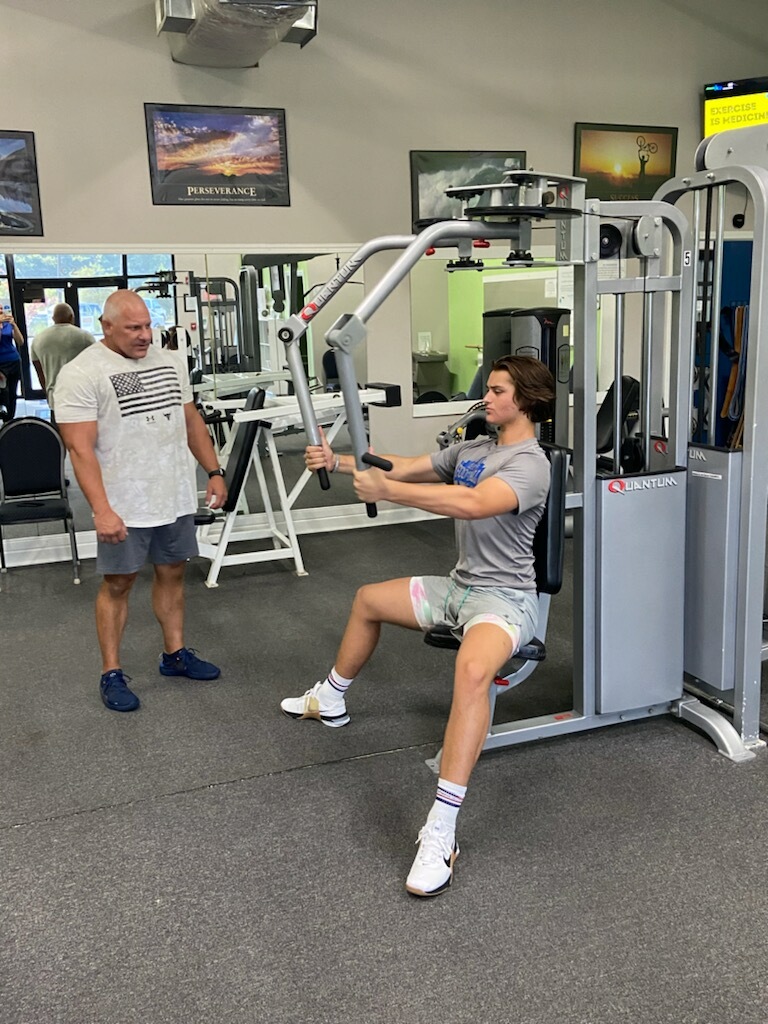
Training can begin in middle school, focused on basic running, jumping and landing mechanics. Make sure the intensity is right for your child’s age and skill level.
When kids get active in sports or training, the benefits are clear. They’ll build self-esteem, get better grades, develop leadership skills and form friendships. This is in addition to the great physical health benefits they’ll reap.
There can be downsides. Too much training or competition can be stressful, especially for young kids.
It’s possible for your child to experience the good without the bad.
Where to begin
Introduce your child to a sport and intensity level that’s age- and skill-appropriate.
Training can begin in middle school. At first, kids should focus on learning how to use their bodies. Start with practicing basic running, skipping, jumping and landing mechanics.
Avoid pressuring them to choose a single sport to focus on too early. Children should play a variety of sports to develop a strong foundation of athletic skills. When they pick a primary sport, this foundation can make them a better and healthier overall athlete.
Choosing a sport and training program
Pay attention to cues from your child about what they want. As a teen, they may want to focus on one or two sports. You can provide encouragement and even help them find a specialized training program for their sport of choice.
If your child is interested in a training program, do your homework. Your child’s training program should be based on best practices and research, not guesswork.
Find a program with a team that has all the right certifications and experience. Young athletes should learn techniques based on scientific principles and backed by national organizations.
These programs should also be designed around your child’s specific needs. Look for programs that test athletes before and after the training program, such as Alpha Athletics. This shows kids exactly what they’ve accomplished.
When to take a step back
If your child seems overwhelmed, it might be time to take a different path, either temporarily or permanently. Pushing too hard can cause burnout and puts kids at a higher risk of injury.
Variety can help prevent burnout and stress. In the off-season, introduce a different activity that complements their chosen sport. For example, football players get great benefits from yoga.
The bottom line is children aren’t small adults. To keep your child happy and healthy, pay attention to their behavior and talk to them about how they’re feeling. Make sure they know it’s OK to feel overwhelmed and ask for a break.
FOR IMMEDIATE RELEASE
The Fitness Zone Receives 2023 Best of Little River Award
Little River Award Program Honors the Achievement
LITTLE RIVER September 27, 2023 — The Fitness Zone has been selected for the 2023 Best of Little River Award in the Fitness Center category by the Little River Award Program.
Each year, the Little River Award Program identifies companies that we believe have achieved exceptional marketing success in their local community and business category. These are local companies that enhance the positive image of small business through service to their customers and our community. These exceptional companies help make the Little River area a great place to live, work and play.
Various sources of information were gathered and analyzed to choose the winners in each category. The 2023 Little River Award Program focuses on quality, not quantity. Winners are determined based on the information gathered both internally by the Little River Award Program and data provided by third parties.
About Little River Award Program
The Little River Award Program is an annual awards program honoring the achievements and accomplishments of local businesses throughout the Little River area. Recognition is given to those companies that have shown the ability to use their best practices and implemented programs to generate competitive advantages and long-term value.
The Little River Award Program was established to recognize the best of local businesses in our community. Our organization works exclusively with local business owners, trade groups, professional associations and other business advertising and marketing groups. Our mission is to recognize the small business community’s contributions to the U.S. economy.
SOURCE: Little River Award Program
CONTACT:
Little River Award Program
Email: PublicRelations@businesshonorlocal.com
URL: http://www.businesshonorlocal.com
###
South Carolina’s fresh, cool fall is ideal for a heart-pumping workout. The cool temperatures are a great way to keep you alert and your body temperature cooler, longer even in the most grueling exercises!
Challenges are at the heart of staying healthy, and fall is the best time to put yourself to the test! So, bundle up into your favorite autumn workout clothes—and get away from pounding your feet on treadmills and the constant crash of weights—with seven ways to exercise in the fall!
1. Walking

Walking is one of the easiest and most fun ways to get in an autumn workout! Go for a walk around your neighborhood or one of your favorite local parks, and get those extra steps and movement into your day. Plus, in the fall, there are a ton of fun activities you can do on your walk! Look for apple picking, corn mazes, leaf peeping opportunities, or pumpkin patches around your local area and make your walk a fall extravaganza! Maybe you can even walk to Starbucks and pick up a (skinny) Pumpkin Spice Latte to take your fall theme to whole other level.
2. Biking

With the cool, crisp air and the leaves turning shades of red, orange, and yellow, fall is a beautiful time to go biking! An hour-long bike ride can burn plenty of calories with little effort from you. Just peddle your heart out! If the weather is a little too chilly for you or the outdoors isn’t really your thing, classes like SPRINT or RPM are a great way to get the bike ride feel at a more intense—indoor—speed.
3. Hiking
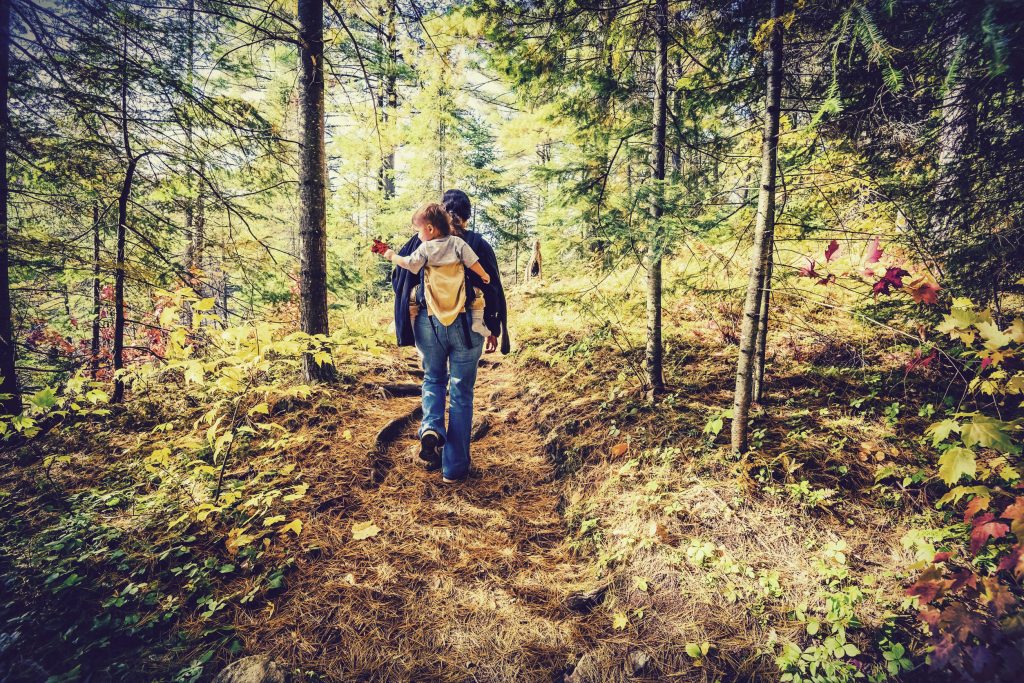
Take a hike! No, really. You should definitely take a hike this fall! Not only are you getting outside and enjoying the beauty of an Indiana fall, but you’re also getting a great workout in! You’ll kick up your cardio and work some major muscles groups—glutes, hamstrings quads, calf muscles, and feet.
4. Running

Running in place on a treadmill can get old fast, especially when you see how beautiful it is outside. Fall is the BEST time to run outdoors! It’s not too hot and not too cold. All you need is a light jacket! Want to challenge yourself on your next run? Bring your four-legged friend along and try to keep up with their pace. Have a cause you’re absolutely passionate about? Find a charity near you that supports that cause and sign up for a race! It doesn’t matter if you walk or run a 5k. All that matters is you’re out there exercising and raising money for something you truly care about.
5. Outdoor Sports

Who’s ready to shoot some hoops, score a goal, or make a touchdown? Get a group together—your family or a group of friends—and start a game of soccer, football, basketball, or any other activity you love! Playing a sport with your friends and family is a great way to get outside and work out without feeling like you’re exercising. An hour-long game can get your heart pumping, work multiple muscles groups, and burn off a ton of calories! Win or lose, you’ll have a blast and a fun workout.
6. Trail Runs

Love hiking and running? Try combining them! Going on a trail run is a great way to get your cardio in and take in the beauty of the trails. Plus, with the uneven ground and changing elevation, a trail run can improve your heart health and build muscle! Cardio and strength all in one workout? Why wouldn’t you take advantage? What’s more, a trail run also helps with your balance. Put those yoga skills to good use by dodging uneven ground, rocks, twigs, and sharp turns with your core.
7. Group Classes
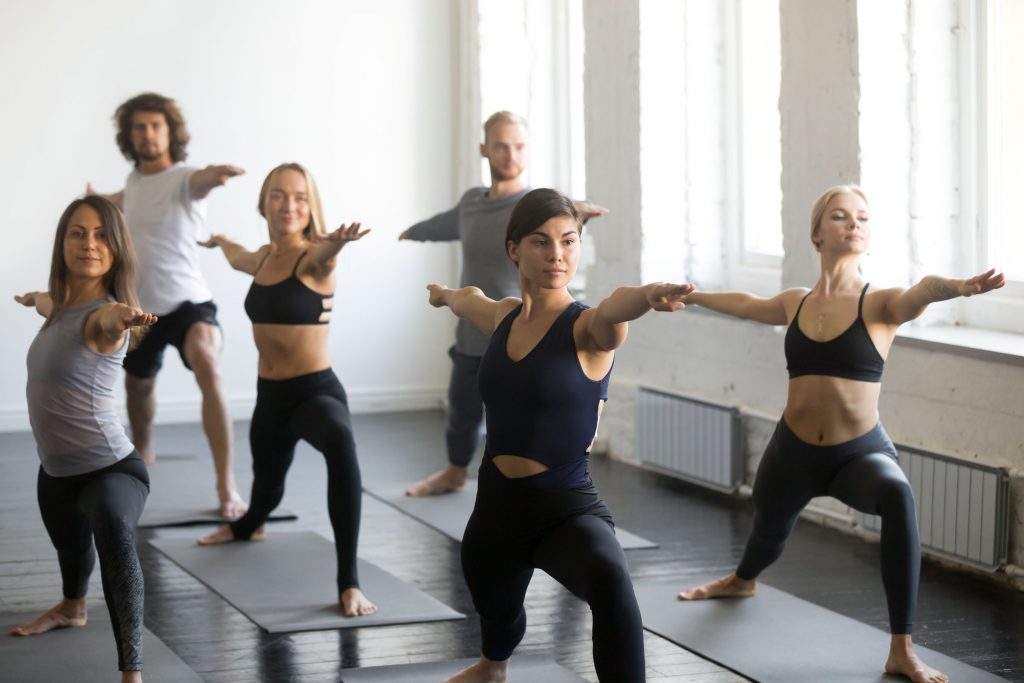
Fall is all fun and games until the temperature begins to drop. Finding the motivation to exercise outside can get a lot more difficult when the weather gets chilly and you’re trying to balance work, your kids’ school—and extracurriculars—and a regular workout routine. Escape the cold with a group fitness class! These one-hour workouts are designed to get your heart rate up and give you the opportunity to socialize with your friends in class. Oh, and don’t worry about your kids. If you’re only able to make it to the gym after school, Alpha Athletics is built to keep your kids safe and having fun while you get your sweat on.
Winter is quickly approaching, so take advantage of the beautiful fall weather before the snow hits! Whether you love to run, walk, bike, hike, or stay indoors with a group fitness class, you can always find new ways to exercise in the fall.
With our location in Little River, South Carolina, the Fitness Zone is committed to healthy living and social responsibility.
Fall fitness time! I’ve noticed that parking at my gym in the mornings has become a bit more of challenge the last couple weeks. The weather is cooling off, school has started, and people are finding their way back to the gym. Indoor exercise always seems to pick up in the fall.
How can I begin fall fitness when I head back to the gym?
If you have been active this summer, this becomes a much easier question to answer. You can probably jump back into any routine you have used previously and see success/progress. Modifying weight and some of the exercises may be necessary to start, but you’ll be back to feeling comfortable and confident in no time.
If you haven’t been as active this summer, for whatever reason, getting back to the gym can be a much more daunting task. Scheduling time can be a limiting factor and soreness is inevitable.
Regardless of which group you are in, the following are key to your success back at the gym:
- Set reasonable, SMART Goals. These goals will help motivate you. SMART Goals are:
- Specific
- Measurable
- Achievable
- Relevant
- Time Bound
- Resistance training is important but remember to start off easy. Jumping back into an old routine at the levels that you were at before can cause excessive soreness or injury.
- Cardio in the gym or an indoor setting is different than some of the cardio that you’ve been doing outside. Gym equipment is less modifiable for individual stride lengths and foot placements. Make sure you are setting the gym equipment to the right settings for your height and weight.
- Flexibility is the key to success. Mobility exercises are very important as you get back into your gym routine. They help with eliminating soreness but also help protect us from injury and can also be a very good active warmup or cool down.
- Variety is important. Variety is important for several reasons as you get back into exercise. From preventing overuse injury to keeping us interested and motivated, variety is key.
Our individualized exercise plans evolve throughout the year. As your fall fitness program changes, make sure it changes in a smart, fun and appropriate way. Remember that there is no perfect exercise, exercise machine, or workout plan that works for everyone. There is though, a great plan out there that’s perfect for you. Good luck in finding that perfect plan!
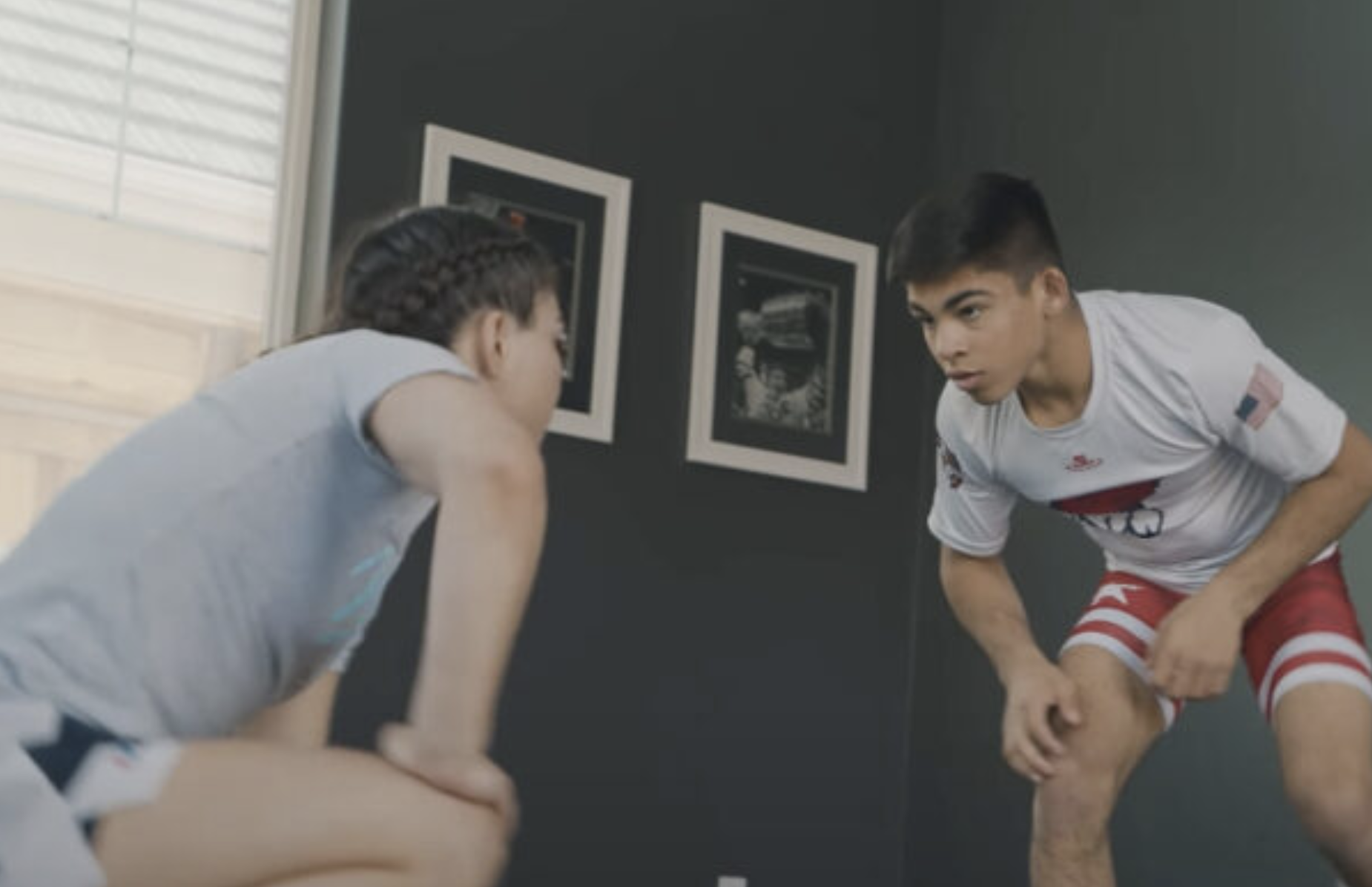
Eye-Hand Coordination: A Guide to Mastery
Introduction
In the myriad of complex human abilities, one often slips under the radar despite its profound impact on our daily tasks: eye-hand coordination. At its core, eye-hand coordination refers to the synchronized control of our ocular and manual movements, allowing us to perform tasks as simple as picking up a pen to as intricate as playing a musical instrument or performing surgery. Although many might not give it a second thought, it’s this very synchronization that makes so many facets of our lives seamless and efficient.
Every time we tie a shoelace, sketch a drawing, or catch a flying ball, we’re relying on this intricate dance between our vision and our hand movements. Yet, for all its ubiquity, the potential to harness and enhance this coordination often remains underestimated. In this guide, we’ll dive deep into understanding, appreciating, and mastering eye-hand coordination, showcasing its pivotal role in both common tasks and outstanding feats.
Grasping Eye-Hand Coordination
Imagine standing on a serene beach, toes sinking into the warm sand, as you watch a child chase a kite. The child’s eyes follow the kite intently, while their hands and arms move in perfect synchronization, tugging the string, making the kite dip and soar. This visual, though simple and everyday, exemplifies the intricate dance of eye-hand coordination in action. But what exactly is happening behind the scenes in such instances? Let’s dive in.
- Definition and Importance: Eye-hand coordination is the synchronized control and processing of visual input (what we see) and hand movement to execute a task. It’s not just about how quickly we react to what we see but how accurately our hands respond to that visual stimulus. This synchronization is crucial in tasks that range from the mundane, like buttoning a shirt, to the complex, like playing a fast-paced video game or driving a car in heavy traffic.
- The Brain’s Role: The brain is the maestro of this complex symphony. When our eyes perceive an object or movement, the visual cortex in the brain processes this information. Simultaneously, other parts of the brain related to motor skills, like the cerebellum and the basal ganglia, start preparing our hands for action. This intricate neural network allows our hands to respond accurately to the visual cues.
- Developmental Perspective: Eye-hand coordination begins to develop early in life. Babies start by simply staring at their own fingers, gradually progressing to reaching out for objects. By toddlerhood, they can grasp objects, stack blocks, and scribble – all significant milestones in eye-hand coordination. Throughout childhood and into adulthood, these skills continue to refine and can be honed further with specific training.
- Factors Influencing Coordination: Several factors can influence one’s eye-hand coordination:
In essence, eye-hand coordination is a testament to the body’s remarkable ability to integrate visual and motor functions seamlessly. While we often take it for granted, understanding and harnessing this capability can lead to enhanced performance in numerous fields, from athletics to arts and beyond.
Importance of Eye-Hand Coordination
Eye-hand coordination, sometimes termed hand-eye coordination, is one of those background skills we often don’t consider until faced with a task that challenges it. However, its impact and importance touch almost every facet of our lives. From the time we are infants reaching out to grasp a parent’s finger to older adults navigating daily tasks, this skill underpins our interactions with the world around us. Let’s shed some light on why eye-hand coordination is so pivotal.
- Daily Living Activities: At the most basic level, we rely on eye-hand coordination for everyday tasks:
Pathways to Improvement
Developing and honing eye-hand coordination is a continuous journey. While we naturally develop this skill as children, it can be further refined and even regained if diminished. Several pathways offer both fun and practical approaches to improvement. Let’s dive into these pathways and understand their contributions.
- Engaging in Skill-Based Sports:
Athletics Success Stories in Eye-Hand Coordination
The world of sports offers compelling examples of how exceptional eye-hand coordination can lead to unparalleled success. Let’s dive into the stories of three superstars whose mastery in this domain has made them legends in their respective sports.
- The Sharpshooter: Steph Curry
- Story: Stephen Curry, often hailed as the best shooter in NBA history, wasn’t always the towering figure he is today. Overlooked by major colleges and doubted by many because of his size, Curry’s extraordinary eye-hand coordination transformed his game.
- Eye-Hand Coordination’s Role: Whether it’s shooting from beyond the arc or navigating through a defense, Curry’s ability to see, process, and act with his hands, often releasing the ball within milliseconds, is unparalleled. This skill, combined with his rigorous training and relentless work ethic, has made him a two-time MVP and multiple-time NBA champion.
- The Ice Maestro: Sidney Crosby
- Story: Sidney Crosby, captain of the Pittsburgh Penguins, is considered one of the greatest hockey players of his generation. From a young age, he showcased a knack for understanding the game and controlling the puck.
- Eye-Hand Coordination’s Role: On the ice, Crosby’s exceptional eye-hand coordination allows him to control the puck, dodge defenders, and score with precision. His skill in deflecting pucks mid-air into the net or executing perfect passes demonstrates the vital role of coordination in his success.
- The Gravity-Defier: Simone Biles
- Story: Simone Biles, with her collection of Olympic gold medals, stands as the most decorated gymnast of all time. Her routines are a blend of power, grace, and intricate maneuvers that leave spectators in awe.
- Eye-Hand Coordination’s Role: In gymnastics, where a split-second mistake can lead to severe injuries, Biles’ flawless coordination stands out. Whether she’s on the balance beam, the floor, or vaulting, her ability to synchronize her sight with intricate hand placements and body movements results in performances that are nothing short of art.
Conclusion
In today’s fast-paced world, the art of synchronization between our eyes and hands plays an indispensable role, stretching beyond just the realms of sports. As we’ve seen from the captivating journeys of elite athletes like Steph Curry, Sidney Crosby, and Simone Biles, the mastery of eye-hand coordination can lead to groundbreaking achievements. This synchronization is a testament to the untapped potential within us, awaiting its due diligence of nurturing and refinement.
Whether you’re aiming for professional greatness or simply wish to enhance daily functions, the journey to improve your eye-hand coordination is a worthy pursuit. Its benefits permeate numerous aspects of life, from executing tasks with precision to enjoying leisure activities with increased proficiency.
Shoulder Strain, WHAT IS IT?
The rotator cuff is often the problem in shoulder strain injuries, including impingement syndrome and glenoid labrum tears. Rotator cuff tendinopathy is a microtrauma/overuse injury which is typically caused by training programming errors, excessive weight progression, and improper form.
“If the rotator cuff is weak, fatigued, or simply not properly engaged, the upward pull of the deltoid will often pinch the supraspinatus (top portion of the cuff) up against the underside of the acromion (top part of the shoulder blade that meets up with the collar bone. This will often result in some swelling and inflammation of the tendon, possibly some swelling and inflammation of the subacromial bursa (little cushion-like structure between the cuff and acromion), and thereby put the squeeze on the supraspinatus while the shoulder is in motion, thus driving continued discomfort.
For some lifters, the cuff may eventually begin to fray by this pinch and rub cycle, leading to degenerative tears or partial tears of the cuff.
RISK FACTORS
Consider the barbell overhead press: Though not recommended, it can be performed with the bar behind the head. When this form is used, excessive stress is placed on anterior structures, like the supraspinatus.
It is recommended to be careful while performing behind-the-neck military presses and other exercises where the arm is abducted and externally rotated.
RECOMMENDATIONS
it is suggested to train the rotator cuff itself to minimize injury risk. The key is generally to train the rotator cuff with resistance below the level that will elicit too much work from the deltoid and pectoralis muscles. Also, don’t forget to work the scapular stabilizers: the trapezius and rhomboids.
- Inflammation phase: no pressing motions, upright row, or lateral raises. Lat pulldowns (to front of head) are usually OK.
- Repair phase: begin pressing motions, but use underhand (supinated) grip and low weight. Avoid fly-type exercises.
- Remodeling: no explosive exercises, begin non-pressing motions (e.g., lateral raise), transition to pressing motions. Upright row might still be problematic as it places the shoulder in an unnatural, impinged position at the top of the motion.
Low Back Pain WHAT IS IT?
Low back pain can result from a strain of the muscles surrounding the spine due to overuse, bulging or severely damages spinal discs, or a macro traumatic injury to the disc. Spinal fractures from weightlifting are uncommon but not unheard of, including a chronic form of stress fracture called spondylolysis, as well as an acute compression fracture of one of the vertebral bodies.
RISK FACTORS
A few of the risk factors for back injuries include position of the back during a weightlifting exercise, the amount the lifter can (or can’t) engage the entire core to support the back, pre-existing back issues, and daily habits unrelated to the gym. Jobs with prolonged sitting as well as jobs with heavy lifting can both pose risks to the lumbar spine.
During a lift, if you’re using too much weight and your back rounds, you might’ve injured your back. Severe, unrelenting pain, inability to move the muscles of the legs, and trouble controlling bowel/bladder function, are indicators of an injury. Pain running down the back of the thigh toward the lower leg often indicates irritation of the sciatic nerve, but could also be caused by a muscle spasm in the low back or glutes.
RECOMMENDATIONS
The inflammation phase (injury is stabilized) of all musculoskeletal injuries is 5-7 days, and during this time it is suggested to avoid Romanian deadlifts (RDL), overhead squats, weighted squats, and all twisting motions. The repair (tissue formation begins) phase starts up to seven after the injury and can last up to two months. RDLs with light weight are OK during this phase, but avoid good mornings and Olympic lifts such as the hang/power clean. The remodeling phase (type 1 collagen production) can last anywhere from 2-4 months to a year, and we recommend adding the good morning exercise and slowly increasing weight with squats and integrating Olympic movements.
If you need help with back pain we recommend visiting our Physical therapy clinic, The Human Performance & Wellness Center.
“Lifting with a well-positioned, neutral-posture spine goes a long way to minize the risks of low back injury,” Mendler adds.
